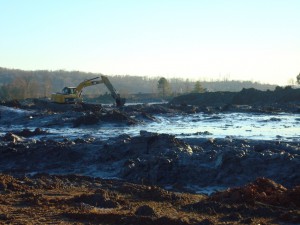

The Deadline is Set for EPA Coal Ash Rule
Thursday, January 30th, 2014 | Posted by Amy Adams | No Comments
 By the end of this year, the EPA will finally publish the first-ever federal rule regulating the disposal of coal ash. The agency’s December 19 deadline is the result of a settlement reached today in a lawsuit brought by Earthjustice, representing Appalachian Voices, Southern Alliance for Clean Energy and other groups. The law, strong science and good public policy all support regulating coal ash as a hazardous waste. Will the EPA stand up for environmental and public health?
[ Read More ]
By the end of this year, the EPA will finally publish the first-ever federal rule regulating the disposal of coal ash. The agency’s December 19 deadline is the result of a settlement reached today in a lawsuit brought by Earthjustice, representing Appalachian Voices, Southern Alliance for Clean Energy and other groups. The law, strong science and good public policy all support regulating coal ash as a hazardous waste. Will the EPA stand up for environmental and public health?
[ Read More ]Concerns Grow Over the EPA’s Stance on Selenium Pollution
Thursday, July 25th, 2013 | Posted by Erin Savage | 3 Comments
In February, we wrote about the new selenium water quality standards being proposed by the Kentucky Division of Water and urged concerned citizens to express their concern to the state. Now, Kentucky has gone ahead with its proposal, submitting the new standards to the EPA for review. While the EPA may deny Kentucky’s proposed standards, concerns are growing that the EPA, influenced by states beholden to their mining industries, may release its own inadequate standard. That is why we are urging people to tell EPA to stop Kentucky, and to require strong, enforceable standards in every state.
Selenium is of particular concern in Kentucky and other Central Appalachian states because it is often released into streams through mountaintop removal coal mining and is toxic to aquatic life at very low levels. Even though many high-selenium coal seams are mined in Kentucky, companies typically claim there will be no selenium discharge when first applying for a permit, so that the pollutant is not included on the permit. Selenium has rarely been included on mining permits in Central Appalachia, effectively allowing companies to avoid monitoring or treating it, unless citizens force them to with lawsuits. A recent victory in a lawsuits over illegal selenium discharges from a Virginia surface mining operation indicates that selenium pollution is a widespread problem at mountaintop removal mines across Central Appalachia.
Kentucky has faced increased pressure from citizens and the EPA to include selenium standards on pollution discharge permits, so that water quality is adequately protected. Unfortunately for the coal companies, selenium is expensive to treat and difficult to keep out of streams impacted by surface mining in high-selenium coal seams. Adding selenium to permits would mean that many coal companies have to start paying for a much larger portion of the damage they create. It appears that the state is helping coal companies find a way to avoid responsibility for selenium discharges. By increasing the legal limit of selenium allowed in streams and including fish tissue-based standards that are difficult, if not impossible to enforce, the state will allow many companies to continue to skirt their responsibility to the land and the people of Kentucky.
(more…)
Coal Ash Update: Legislatin’, Litigatin’ and Fillin’
Monday, July 1st, 2013 | Posted by | No Comments

The N.C. Department of Environment and Natural Resources sued Duke Energy to stop coal ash pollution from contaminating Mountain Island Lake, the Charlotte Metro area’s primary drinking water source. Click the photo to watch a short video.
“Passing a bad piece of coal ash legislation prolongs our pollution problem and makes the possibility of an accident much more of a reality.”
These words, from a recent letter to the editor in the Asheville Citizen-Times, reflect the growing discomfort over coal ash storage and how legislators are tackling the problem.
Coal ash is the waste byproduct from burning coal, and is stored in large unlined, earthen ponds, usually near waterways. It contains toxic chemicals such as lead, arsenic and selenium, and can leak from the ponds into groundwater. When improperly constructed and inspected, coal ash ponds can burst — the most horrific example of this occurred in 2008, when a pond at TVA’s Kingston, Tenn., coal plant ruptured and more than 1 billion gallons of the toxic substance surged into local waters and communities. Cleanup efforts are ongoing.
In the wake of the Kingston coal ash disaster many called for federal regulations on coal ash storage. While the U.S. Environmental Protection Agency has repeatedly delayed releasing the rule, which could be released as early as 2014, many at the state and federal level have tried to stop the EPA from doing just that.
(more…)
The Mayan Calendar Has Ended, And There is Still Coal Ash in the Tennessee River
Friday, December 21st, 2012 | Posted by Sandra Diaz | No Comments
So the world did not end today, as much of the discussion around the end of Mayan calendar seemed to suggest. But it might have seemed like that to the residents of Harriman, Tn. exactly four year ago today, when an earthen dam at a nearby power plant failed, and 1 billion gallons of coal ash waste flooded across fields and farmland and oozed into nearby rivers. The amount spilled is enough to fill 1,500 Olympic-sized swimming pools.
Though no one was directly hurt or killed, the catastrophe at the Tennessee Valley Authority power plant surely devastated lives. People got sick from the fumes coming off the ash and had to boil their water. Property values plunged, compelling people to sell their homes and property to TVA. Dangerous heavy metals were released into the Emory River, a tributary of the Tennessee River.
It was the first time a majority Americans learned what coal ash was and how dangerous it could be. People were shocked to know that a waste product from burning coal was most often dumped into unlined pits behind earthen dams. More shocking is the fact that, in the absence of federal standards coal ash — laced with heavy metals, known carcinogens and other toxins — is less regulated than household waste.
In the Southeast, we know there are 450 of these impoundments holding back 118 billion gallons of coal ash. Not only is there the risk of a dam breaking, there is the more insidious pollution of our waterways. (See if there is one near you).
I will never forget the day Donna Lisenby, Coal Campaign Coordinator for Waterkeeper Alliance, John Wathen, Hurricane Creekkeeper and I traveled to “ground zero” and paddled to where the Emory River ceased being a river and began to look like a sludge pit. It looked like the end of the world.
Little has happened since the TVA spill. Clean-up that was supposed to take a few weeks still isn’t completed. TVA has decided to allow “natural recovery” to take place, which basically means TVA will stop trying to dredge the river and see if Mother Nature might be able to finish the job with the remaining 9% of the ash still left. (more…)
Read More ...








